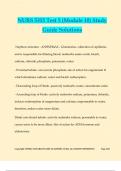NURS 5315 Test 5 (Module 10) Study
Guide Solutions
Nephron structure - ANSWER✔✔-- Glomerulus- collection of capillaries
and is responsible for filtering blood, reabsorbs amino acids, bicarb,
sodium, chloride, phosphate, potassium, water
- Proximal tubule- can excrete phosphate, site of action for angiotensin II
which stimulates sodium, water and bicarb reabsorption.
- Descending loop of Henle- passively reabsorbs water, concentrates urine.
- Ascending loop of Henle- actively reabsorbs sodium, potassium, chloride,
induces reabsorption of magnesium and calcium, impermeable to water,
therefore, makes water more dilute.
Distal convoluted tubule- actively reabsorbs sodium, permeable to water,
causes urine to be more dilute. Site of action for ADH hormone and
aldosterone
Copyright ©EMILLYCHARLOTE 2025 ACADEMIC YEAR, ALL RIGHTS RESERVED. Page 1/21
,Renal blood vessels - ANSWER✔✔-Autoregulation- autoregulation affects
amount of blood flow to kidneys and also rate of filtration. Decrease in
arterial blood pressure and decrease in arterial blood volume causes a
decrease in renal perfusion. Decreased perfusion causes reduced GFR, and
decrease in fluid and sodium in distal tubule. This decrease is senses by
JGA which sends signals to relax blood vessels in order to help bring blood
to glomeruli, JGA releases renin which converts angiotenison to angio I,
this passes through lungs and stimulates release of angiotensin converting
enzyme. ACE converts angio I to angio II, which stimulates
vasoconstriction to help increase glomerular back pressure and increase
GFR. Angio II also responsible for stimulating release of aldosterone. This
results in additional reabsorption of water, increased BP and increased GF
rate.
aging effect on kidneys - ANSWER✔✔-Reach adult size by adolescence
Hypertrophy with older age, reduced ability to excrete urine, kyperkalemia
from reduced excretion, more glucose excreted because of decreased
reabsorption (not necessarily indicator of diabetes), drugs not clearing as
easily, harder to activate vitamin d, which affects calcium absorption.
Copyright ©EMILLYCHARLOTE 2025 ACADEMIC YEAR, ALL RIGHTS RESERVED. Page 2/21
, GFR- increased directly after birth, reaches adult levels by age 2, more
dilute urine up to 6mo of age, renal blood flow and GFR decrease with
older age (d/t atherosclerosis)
Nephron- decrease in number and size with age (atherosclerosis), number
of nephrons at age 75 decreased by 30%.
Tubular system- immature in infants (harder to excrete potassium,
reabsorb bicarb, buffer hydrogen), matures by age 2. Tubular atrophy is
common with age.
Bladder- descends into pelvis after birth, may not void for 12-24 hours
following birth. Frequency and nocturia are common with age.
Renal injury - ANSWER✔✔-Focal- localized, <50% of glomeruli affected
Copyright ©EMILLYCHARLOTE 2025 ACADEMIC YEAR, ALL RIGHTS RESERVED. Page 3/21




